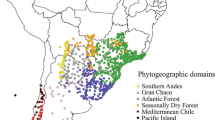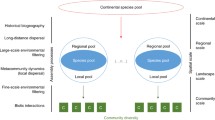Abstract
From a total woody flora of ca. 1000 species, a suite of 121 species forms an oligarchy dominating the cerrado biome. This mirrors patterns of dominance described in western Amazonian rain forests. Widespread sampling shows that across the biome this suite of species contributes on average 66% of the total species composition, and 75% of the total Importance Value Index in cerrado communities. An analysis of the floristic similarity between six cerrado phytogeographic provinces (southern, central and south-eastern, central-western, far-western, north-eastern, disjunct Amazonian) reveals great heterogeneity within the biome, principally of the less common species. Of the 951 species recorded from 375 floristic surveys across the biome, 494 species (more than half of the total) are found in only one of the provinces, with very few species (37, i.e., 3.9%) found in all six provinces. Each of the provinces contains a significant number of species which are apparently confined to it, ranging from 15 species (1.6% of the total woody cerrado flora) in the far-western province (primarily in the state of Rondônia) to 162 species (17%) in the central-western province. At the local level, floristic similarity can be very high. An analysis of the floristic composition of 13 sites within the Federal District shows a woody flora of 236 species, indicating that 25% of the total woody flora of the cerrado biome is represented in 0.3% of its area, illustrating the great conservation importance of this region. Floristic similarity between sites within the Federal District is high, although much of this similarity is accounted for by ‘oligarch’ species which account for between 59 and 89% of total species recorded per site. Informed conservation judgements within the cerrado need to take account of regional floristic patterns to ensure maximum protection of biodiversity, as the majority of species are not geographically widespread within the biome.
Similar content being viewed by others
References
Araújo G.M. de, Nunes J.J., Rosa A.G. and Resende E.J. 1997. Estrutura comunitária de vinte áreas de cerrados residuais no município de Uberlândia, MG. Daphne, Belo Horizonte 7: 7–14.
Azevedo L.G. de, Ribeiro J.F., Schiavini I. and Oliveira P.E.A.M. 1990. Levantamento da vegetação do Jardim Botânico de Brasília – Distrito Federal. Fundação Zoobotânica, DF, Brazil.
Balvanera P., Lott E., Gerardo S., Siebe C. and Islas A. 2002. Patterns of b-diversity in a Mexican tropical dry forest. Journal of Vegetation Science 13: 145–158.
Cardoso E., Moreno M.I.C. and Guimarães A.J.M. 2002. Estudo fitossociológico em área de cerrado sensu stricto na Estação de Pesquisa e Desenvolvimento Ambiental Galheiro – Perdizes, MG. Caminhos de Geografia 3: 30–43.
Castro A.A.J.F. 1994. Comparação florístico-geográfica (Brasil) e fitossociológica (Piauí – São Paulo) de amostras de cerrado. Doctoral Thesis, State University of Campinas, SP, Brazil.
Castro A.A.J.F. and Martins F.R. 1999. Cerrados do Brasil e do Nordeste: caracterização, área de ocupação e considerações sobre a sua fitodiversidade. Pesquisa em Foco, São Luís 7: 147–178.
Castro A.A.J.F., Martins F.R., Tamashiro J.Y. and Shepherd G.J. 1999. How rich is the flora of Brazilian cerrados? Annals of the Missouri Botanical Garden 86: 192–224.
Cavalcanti R.B. (Scientific Co-ordinator) 1999. Ações prioritárias para conservação da biodiversidade do Cerrado e Pantanal, Brasília, DF, Brazil. Ministério de Meio Ambiente, Funatura, Conservation International, Fundação Biodiversitas, University of Brasília, Brazil.
Condit R., Pitman N., Leigh E.G., Chave J., Terborgh J., Foster R.B., Núñez V., Aguilar S., Valencia R., Villa G., Muller-Landau H.C., Losos E. and Hubbell S.P. 2002. Beta-diversity in tropical forest trees. Science 295: 666–669.
Dias B.F. de S. 1992. Chapter 2. Cerrados: uma caracterização. In: Dias B.F. de S. (co-ordinator). Alternativas de desenvolvimento dos cerrados: manejo e conservação dos recursos naturais renováveis. FUNATURA – IBAMA, Brasília, DF, Brazil, pp. 11–25.
Duivenvoorden J.F., Svenning J.-C. and Wright S.J. 2002. Beta diversity in tropical forests. Science 295: 636–637.
Eiten G. 1972. The cerrado vegetation of Brazil. The Botanical Review 38: 201–341.
Eiten G. 2001. Vegetação natural do Distrito Federal. Serviço de apoio às micro e pequenas Empresas do Distrito Federal (SEBRAE), Brazil.
Eiten G. and Sambuichi R.H.R. 1996. Effect of long-term periodic fire on plant diversity in a cerrado region. In: Pereira R.C. and Nasser L.C.B. (eds) Anais VIII Simpósio Sobre o Cerrado/ Proc. 1st International Symposium on Tropical Savannas. EMBRAPA/CPAC, Planaltina, DF, Brazil, pp. 46–55.
Fagan W.F. and Kareiva P.M. 1997. Using compiled species lists to make biodiversity comparisons among regions: a test case using Oregon butterflies. Biological Conservation 80: 249–259.
Felfili J.M. and Silva Jr. M.C. 1993. A comparative study of cerrado (sensu stricto) vegetation in Central Brazil. Journal of Tropical Ecology 9: 277–289.
Felfili M.C. and Silva Junior M.C. 2001. Biogeografia do bioma cerrado: Estudo fitofisionêmico na Chapada do Espigão Mestre do São Francisco. Ministry of the Environment/University of Brasília, Brazil.
Furley P.A. and Ratter J.A. 1988. Soil resources and plant communities of the central Brazilian cerrado and their development. Journal of Biogeography 15: 97–108.
Furley P.A., Ratter J.A. and Gifford D.R. 1988. Observations on the vegetation of eastern Mato Grosso. III. The woody vegetation and soils of the Morro de Fumaça, Torixoreu. Proceedings of the Royal Society B 235: 259–280.
Heringer E.P. 1971. Propagação e sucessão de espécies arbóreas do cerrado em função do fago, do cupim, da capina e do aldrin (insecticida). In: Ferri M.G. (co-ordinator), III Simpósio sobre o cerrado. Editora Edgard Blücher Ltda, São Paulo, Brazil, pp. 167–179.
Marimon B.S., Varella R.F. and Marimon B.H. 1998. Fitossociologia de uma área de cerrado de encosta em Nova Xavantina, Mato Grosso. Boletim do Herbário. Ezechias Paulo Heringer 3: 82–101.
Mendonça R.C. de, Felfili J.M., Walter B.M.T., Silva Júnior M.C. da, Rezende A.V., Filgueiras T.S. and Nogueira P.E. 1998. Flora vascular do cerrado. In: Sano S.M. and Almeida P. de (eds) Cerrado ambiente e flora. Empresa Brasileira de Pesquisa Agropecuária, pp. 289–539.
Milliken W. and Ratter J.A. 1989. The vegetation of the Ilha de Maracá first report of the vegetation survey of the Maracá Rainforest Project (INPA/RGS/SEMA). Royal Botanic Garden Edinburgh, UK.
Miranda I.S. 1997. Flora, fisionomia e estrutura das savanas de Roraima, Brasil Doctoral Thesis, Instituto Nacional de Pesquisas da Amazênia, Manaus, AM, Brazil.
Mistry J. 2000. World Savannas. Ecology and Human Use. Longman, Harlow, UK.
Myers N., Mittermeier R.A., Mittermeier C.G., Fonseca G.A.B. and Kent J. 2000. Biodiversity hotspots for conservation priorities. Nature 403: 853–858.
Oliveira-Filho A.T. and Martins F.R. 1991. A comparative study of five cerrado areas in southern Mato Grosso, Brazil. Edinburgh Journal of Botany 48: 307–332.
Oliveira-Filho A.T. and Ratter J.A. 2002. Vegetation physiognomies and woody flora of the cerrado biome. In: Oliveira P.S. and Marquis R.J. (eds) The Cerrado of Brazil: Ecology and Natural History of a Neotropical Savanna. Columbia University Press, New York, pp. 91–120.
Pereira B.A.S., Mendonça R.C., Filgueiras T.S., Paula J.E. and Heringer E.P. 1985. Levantamento florístico da área de Proteção Ambiental (APA) da Bacia do Rio São Bartolomeu, Distrito Federal. Anais do XXXVI Congresso Nacional de Botânica, pp. 419–493.
Pereira B.A.S., Silva M.A. and Mendonça R.C. 1993. Reserva Ecológica do IBGE, Brasília (DF): Lista das plantas vasculares. Fundação Instituto Brasileiro de Geografia e Estatística (IBGE), Rio de Janeiro, Brazil.
Pitman N.C.A., Terborgh J., Silman M.R. and Núñez P. 1999. Tree species distributions in an upper Amazonian forest. Ecology 80: 2651–2661.
Proença C.E.B., Munhoz C.B.R., Jorge C.L. and Nórbrega M.G.G. 2001. Listagem e nível de proteção das espécies de fanerógramas do Distrito Federal, Brasil. In: Cavalcanti T.B. and Ramos A.E. (eds) Flora do Distrito Federal, Brasil. Embrapa Recursos Genéticos e Biotecnologia, Brazil.
Ramos P.C.M. 1995. Vegetation communities and soils of Brasília National Park. Doctoral Thesis, University of Edinburgh, UK.
Ratter J.A. 1986. Notas sobre a vegetação da Fazenda Água Limpa (Brasília, DF, Brasil). Editora UnB Textos Universitários No. 003, Brasília, Brazil.
Ratter J.A. 1987. Notes on the vegetation of the Parque Nacional do Araguaia (Brazil). Notes of the Royal Botanic Garden, Edinburgh 44: 311–342.
Ratter J.A. and Dargie T.C.D. 1992. An analysis of the floristic composition of 26 cerrado areas in Brazil. Edinburgh Journal of Botany 49: 235–250.
Ratter J.A., Richards P.W., Argent G. and Gifford D.R. 1973. Observations on the vegetation of north eastern Mato Grosso, 1. The woody vegetation types of the Xavantina–Cachimbo Expedition Area. Philosophical Transactions of the Royal Society 226: 449–492.
Ratter J.A., Askew G.P., Montgomery R.F. and Gifford D.R. 1977. Observações adicionais sobre o Cerradão de solo mesotrófico no Brasil Central. In: Ferri M.G. (ed) IV Simpósio sobre o Cerrado, Editora University of São Paulo, São Paulo, Brazil, pp. 303–316.
Ratter J.A., Leitão Filho H.F., Argent G., Gibbs P.E., Semir R.J., Shepherd G.J. and Tamashiro J. 1988a. Floristic composition and community structure of a southern cerrado area in Brazil. Notes of the Royal Botanic Garden, Edinburgh 45: 137–151.
Ratter J.A., Pott A., Pott V.J., Cunha C.N. da and Haridasan M. 1988b. Observations on woody vegetation types in the Pantanal and at Corumbá, Brazil. Notes of the Royal Botanic Garden, Edinburgh 45: 503–525.
Ratter J.A., Bridgewater S., Atkinson R. and Ribeiro J.F. 1996. Analysis of the floristic composition of the Brazilian cerrado vegetation II: comparison of the woody vegetation of 98 areas. Edinburgh Journal of Botany 53: 153–180.
Ratter J.A., Ribeiro J.F. and Bridgewater S. 1997. The Brazilian cerrado vegetation and threats to its biodiversity. Annals of Botany 80: 223–230.
Ratter J.A., Bridgewater S. and Ribeiro J.F. 2001. Espécies lenhosas da fitofisionomia cerrado sentido amplo em 170 localidades do bioma Cerrado. Boletim do Herbário Ezechias Paulo Heringer 7: 5–112.
Ratter J.A., Bridgewater S. and Ribeiro J.F. 2003. Analysis of the floristic composition of the Brazilian cerrado vegetation III: Comparison of the woody vegetation of 376 areas. Edinburgh Journal of Botany 60: 57–109.
Raven P.H. 1988. Tropical floristics tomorrow. Taxon 37: 549–560.
Ribeiro J.F. and Walter B.M.T. 1998. Fitofisionomias do bioma cerrado. In: Sano S.M. and Almeida S.P. de (eds) Cerrado ambiente e flora. EMBRAPA–CPAC, Brasília, Brazil.
Ribeiro J.F., Silva J.C.S. and Batmanian G.J. 1985. Fitossociologia de tipos fisionêmicos de cerrado em Planaltina – Distrito Federal. Revista Brasileira de Botânica 8: 131–142.
Rossi C.V., Silva Jr. M.C. and Santos C.E.N. 1998. Fitossociologia do estrato arbóreo do cerrado (sensu stricto) no Parque Ecológico Norte, Brasília, DF. Boletim do Herbário Ezechias Paulo Heringer 2: 49–56.
Ruokolainen K., Linna A. and Tuomisto H. 1997. Use of Melastomataceae and pteridophytes for revealing phytogeographic patterns in Amazonian rain forests. Journal of Tropical Ecology 13: 243–256.
Sambuichi R.H.R. and Eiten G. 2000. Fitossociologia da camada lenhosa de um cerrado em Brasília, DF. Boletim Herbário Ezechias Paulo Heringer 5: 62–87.
Sanaiotti T., Bridgewater S. and Ratter J.A. 1997. A floristic study of the savanna vegetation of the state of Amapá, Brazil, and suggestions for its conservation. Boletim Museu Paraense Emílio Goeldi, Série Botânica 13: 3–29.
Santos E.R. dos 2000. Análise florística e estrutura fitossociológica da vegetação lenhosa de um trecho de cerrado stricto sensu do Parque Estadual do Lajeado, Palmas – TO. Master's Thesis, University of Viçosa, MG, Brazil.
Silva Jr. M.C. da and Felfili J.M. 1996. A vegetação do Estação Ecológica de Aguas Emendadas. SEMATEC/IEMA, Brasília, DF, Brazil.
Thorne R.F. 1992. Classification and geography of the flowering plants. The Botanical Review 58: 225–348.
Valencia R., Balslev H., Paz G. and Miño C. 1994. High tree alpha-diversity in Amazonian Ecuador. Biodiversity and Conservation 5: 25–34.
Walter B.M.T. and Ribeiro J.F. 1996. Fitossociologia de uma reserva ecológica de cerrado adjacente a plantios agricolas. In: Pereira R.C. and Nasser L.C.B. (eds) Anais VIII Simpósio sobre o Cerrado/Proc. 1st International Symposium on Tropical Savanas. EMBRAPA/CPAC, Planaltina, Distrito Federal, Brazil, pp. 242–248.
Whittaker R.H. 1972. Evolution and measurement of species diversity. Taxon 21: 213–251.
Author information
Authors and Affiliations
Rights and permissions
About this article
Cite this article
Bridgewater, S., Ratter, J.A. & Felipe Ribeiro, J. Biogeographic patterns, β-diversity and dominance in the cerrado biome of Brazil. Biodiversity and Conservation 13, 2295–2317 (2004). https://doi.org/10.1023/B:BIOC.0000047903.37608.4c
Issue Date:
DOI: https://doi.org/10.1023/B:BIOC.0000047903.37608.4c




